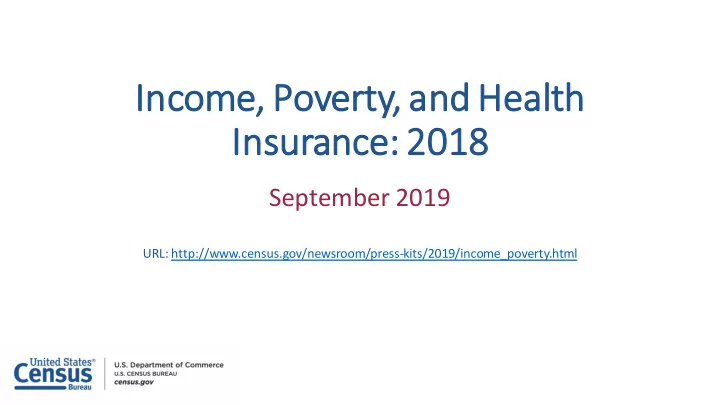

Income me, Poverty ty, a and H nd Health h Insurance ce: 2 : 2018 September 2019 URL: http://www.census.gov/newsroom/press-kits/2019/income_poverty.html
Presen enter ers Host Michael C. Cook, Sr. Chief, Public Information Office Presenters David G. Waddington Chief, Social, Economic, and Housing Statistics Division Trudi J. Renwick Assistant Division Chief, Economic Characteristics Liana E. Fox Statistician, Social, Economic, and Housing Statistics Division Laryssa Mykyta Chief, Health and Disability Statistics Branch
3
• Data are based on the Current Population Survey’s Annual Social and Economic Supplement (CPS ASEC) from March 2019. • CPS ASEC is the official source of national poverty estimates. • Official poverty estimates are calculated in accordance with OMB Statistical Policy Directive 14. 4
• Includes data from the Current Population Survey’s Annual Social and Economic Supplement (CPS ASEC) and the American Community Survey (ACS). • ACS is the recommended source for smaller populations and levels of geography. 5
Important C CPS A S ASEC Su Survey U Updates The CPS ASEC has undergone a redesign of the questionnaire and data processing system. Questionnaire design changes incorporated over the period of 2014 to 2016: • Updated income and means-tested benefit questions • Redesigned health insurance questions • Expanded family relationship categories 6
Important C CPS A S ASEC Su Survey U Updates The CPS ASEC has undergone a redesign of the questionnaire and data processing system. Questionnaire design changes incorporated over the period of 2014 to 2016: • Updated income and means-tested benefit questions • Redesigned health insurance questions • Expanded family relationship categories Data processing changes reflected for the first time this year: Improvements to how income data is edited and imputed • More comprehensive and consistent treatment of families • Expanded data on health insurance coverage and sources • 6
Important Reminders for Today’s P Presentations In today’s presentations: Estimates for 2017 and 2018 reflect the updated processing • system. 2017 estimates may differ from those published last year. • For more information: CPS ASEC Redesign & Processing Changes website: • https://census.gov/data/datasets/time-series/demo/income- poverty/cps-asec-design.html Pre-release webinar on improvements to the CPS ASEC and • implications for estimates: https://www.census.gov/data/academy/webinars.html 7
Real M Median H Household I Income: 1967 to 2018 018 Income in thousands (2018 dollars) Recession 100 90 80 Median household income was 70 $63, 63,200 00 $63,200 in 2018, not statistically 60 different from the 2017 median, 50 following three consecutive years $47, 47,100 00 40 of annual increases. 30 20 10 0 1967 1975 1980 1985 1990 1995 2000 2005 2010 2018 Note: The data for 2017 and beyond reflect the implementation of an updated CPS ASEC processing system. The data for 2013 and beyond reflect the implementationof the redesigned income questions. Income rounded to 8 nearest $100. Source: U.S. Census Bureau, Current Population Survey, 1968 to 2019 Annual Social and Economic Supplements.
Poverty R Rate and Number in P Poverty: 1959 959 to o 2018 018 Percent Recession 25 20 Poverty r rate 22.4% 4% 15 The official poverty rate in 2018 10 was 11.8 percent, down 0.5 11.8% 8% 5 percentage points from 2017. In 0 2018, there were 38.1 million Numbers in millions people in poverty, a decrease of 50 45 1.4 million people from 2017. Num umber i in po n poverty 40 38.1 1 35 39.5 5 million 30 million 25 20 1959 1965 1970 1975 1980 1985 1990 1995 2000 2005 2010 2018 Note: The data for 2017 and beyond reflect the implementation of an updated CPS ASEC processing system. The data for 2013 and beyond reflect the implementationof the redesigned income questions. 9 Source: U.S. Census Bureau, Current Population Survey, 1960 to 2019 Annual Social and Economic Supplements.
Com omparison on o of SPM P Pov overty Estimates: 2017 017 and 2018 018 (In Percent) 2017 2018 14.2 13.7 13.6 13.6 13.0 12.8 12.4 12.2 The Supplemental Poverty Measure (SPM) rate in 2018 was 12.8 percent. This is not statistically different from the 2017 SPM rate of 13.0 percent. All People Under 18 18 to 64 65 years years years and older Source: U.S. Census Bureau, Current Population Survey, 2018 and 2019 Annual Social and Economic Supplements. 10
Health Insurance Cove verage: 2 : 2017 017 and 2018 018 Percent Uninsured 8.5 7.9 +0.5 The percentage of people without health insurance coverage for the entire calendar year was 8.5 percent, a 0.5 2017 2018 percentage-point increase from 2017. In 2018, 27.5 million 27.5 25.6 Number Uninsured people did not have health +1.9 million (in millions) insurance coverage, an increase of 1.9 million people. 2017 2018 Note: The data for 2018 reflect the implementation of an updated CPS ASEC processing system. Source: U.S. Census Bureau, Current Population Survey, 2018 Annual Social and Economic Supplement Bridge File 11 and 2019 Annual Social and Economic Supplement.
[INTRO VIDEOS & PRESENTATIONS FOR EACH SUBJECT AREA]
High ghligh ghts ts Median household income was $63,200 in 2018, not statistically different from the • 2017 median. The official poverty rate in 2018 was 11.8 percent, down 0.5 percentage points from • 2017. In 2018, there were 38.1 million people in poverty, 1.4 million people less than the number in poverty in 2017. The Supplemental Poverty Measure (SPM) rate in 2018 was 12.8 percent. This is not • statistically different from the 2017 SPM rate of 13.0 percent. The percentage of people without health insurance coverage for the entire calendar • year was 8.5 percent, a 0.5 percentage-point increase from 2017. In 2018, 27.5 million people did not have health insurance coverage, an increase of 1.9 million people. Income rounded to nearest $100. Source: U.S. Census Bureau, Current Population Survey, 2018 and 2019 Annual Social and Economic Supplements.
Recommend
More recommend